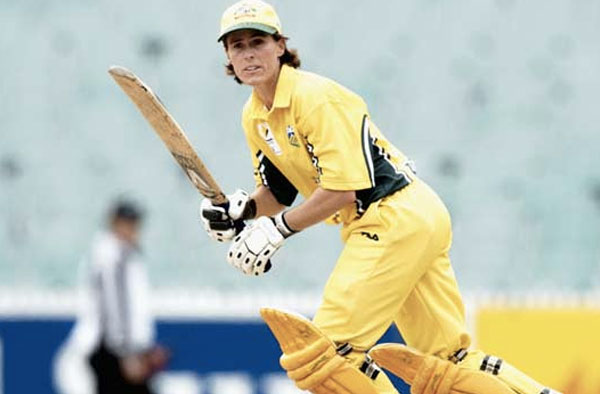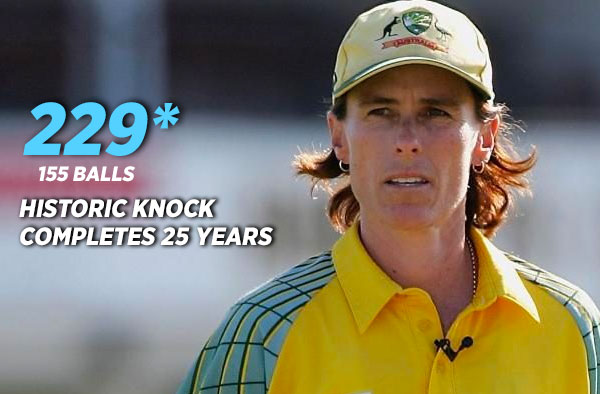25 years ago, a talented Aussie scored an unbelievable 229 off 155 balls and became the first-ever cricketer to score a 200 in Cricket. But how many of us know this?

The women’s game has always set the benchmark in cricket. Be it having the first World Cup in 1973, 2 years before the men’s version in 1975 or owning the distinction of possessing the first double centurion ever in Cricket in the form of Belinda Clark; women’s cricket has quite literally been ‘the trendsetter’ much to everyone’s surprise.
Many achievements that were once deemed impossible are now attainable because of improved batting standards and different approaches toward the game. However, in the late 1990s, a double century in a one-day match was not only unheard of but also unthinkable. Despite the aggressive style in which current cricket is played, the occurrence is still uncommon. Before T20s and other shorter-format tournaments were launched, Belinda Clark’s innings revolutionized cricket and inspired an entire generation and more.
25 Years ago, Exactly #OnThisDay in 1997
229* runs
155 balls
22 fours🇦🇺 Belinda Clark became the first ever cricketer to hit a double 💯 in ODIs #CricketTwitter pic.twitter.com/ChTlRG01Rr
— Female Cricket (@imfemalecricket) December 16, 2022
It was in the ICC Women’s World Cup in 1997 that the then 27-year-old Belinda Clark achieved the impossible and showed the world how it is done. Batting at Bandra’s Middle Income Group (MIG) Ground, Mumbai versus a docile and inexperienced Denmark attack, Belinda Clark was on a whole different level scoring 229. She completely outplayed the Denmark attack and has etched that knock in history books. Australia ended up scoring a mammoth 412/3 and this was the first 400 score in cricket back then. What made her knock all the more special was how Denmark was skittled for a paltry 49. 13 years before the legendary Sachin Tendulkar became the first male cricketer to score a double ton in a 50-over game, Clark’s 229 off 155 was the first. The knock was laced with 22 boundaries and is iconic but what is not spoken about enough was how she ran between the wickets and acclimatized herself seamlessly to the conditions. It was a battle-tested inning, as evidenced by the fact that she was striking at 147 and she was middling the ball beautifully. She also forged crucial partnerships with the now legends, Lisa Keightley and Karen Rolton en route to that brilliant knock.

She was in glorious form in the World Cup and had already scored a crucial 93* versus South Africa and was showing all the indications of a big knock in the coming matches. She was also a young skipper and admirably led Australia to World Cup glory. Considering how women’s cricket is often considered an afterthought and is in the shadows of men’s cricket, unfortunately, the likes of Greg Chappell, Allan Border, and Steve Waugh, three outstanding Australian male captains, are mentioned before Belinda Clark in Australian cricket history.
After taking over the captaincy in 1994, Clark guided the Australian women’s team to two World Cup victories over the course of her 1991–2005 international tenure. Clark has also scored the most runs for Australia amassing 4,844 at an average of 47.49 and has captained the most matches for Australia forging an unbelievable winning rate of 83%. She was selected Wisden’s ‘Australia Cricketer of the Year’ in 1998 and was inducted into the ICC’s ‘Hall of Fame’ in 2011. Unknown to many in the cricketing community, she is the recipient of both awards, much deservingly. For her contributions to cricket, particularly through the Australian Women’s Cricket Team, she was also named a Member of the Order of Australia (AM) in 2000 and there is an award instituted in her name titled, the ‘Belinda Clark Medal’, awarded annually to the best Australian woman cricketer of the year. She previously held the position of CEO for Women’s Cricket Australia.
Her knock has stood the test of time and is still the highest ever in women’s ODI cricket. She is the only Australian to have scored a double century in ODIs among other records that the knock broke. Clark’s illustrious career has many highlights and special moments, but the knock in Mumbai stands out as she enabled women’s cricket to reach greater heights. It is a world record that will undoubtedly endure forever.

I am a first year postgraduate student pursuing a MA in Media and Communication Studies at Christ University, Bengaluru. I am a podcaster, blogger and an avid cricket fan. When not glued to cricket matches, you can find me submerged in books and thinking about cricket all the time.